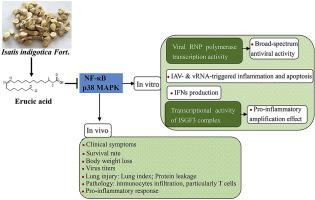Journal of Pharmaceutical Analysis ( IF 6.1 ) Pub Date : 2019-10-04 , DOI: 10.1016/j.jpha.2019.09.005 Xiaoli Liang 1 , Yuan Huang 2 , Xiping Pan 3 , Yanbing Hao 1 , Xiaowei Chen 1 , Haiming Jiang 1 , Jing Li 1 , Beixian Zhou 4 , Zifeng Yang 1, 5

|
Isatis indigotica Fort. (Ban-Lan-Gen) is an herbal medicine prescribed for influenza treatment. However, its active components and mode of action remain mostly unknown. In the present study, erucic acid was isolated from Isatis indigotica Fort., and subsequently its underlying mechanism against influenza A virus (IAV) infection was investigated in vitro and in vivo. Our results demonstrated that erucic acid exhibited broad-spectrum antiviral activity against IAV resulting from reduction of viral polymerase transcription activity. Erucic acid was found to exert inhibitory effects on IAV or viral (v) RNA-induced pro-inflammatory mediators as well as interferons (IFNs). The molecular mechanism by which erucic acid with antiviral and anti-inflammatory properties was attributed to inactivation of NF-κB and p38 MAPK signaling. Furthermore, the NF-κB and p38 MAPK inhibitory effect of erucic acid led to diminishing the transcriptional activity of interferon-stimulated gene factor 3 (ISGF-3), and thereby reducing IAV-triggered pro-inflammatory response amplification in IFN-β-sensitized cells. Additionally, IAV- or vRNA-triggered apoptosis of alveolar epithelial A549 cells was prevented by erucic acid. In vivo, erucic acid administration consistently displayed decreased lung viral load and viral antigens expression. Meanwhile, erucic acid markedly reduced CD8+ cytotoxic T lymphocyte (CTL) recruitment, pro-apoptotic signaling, hyperactivity of multiple signaling pathways, and exacerbated immune inflammation in the lung, which resulted in decreased lung injury and mortality in mice with a mouse-adapted A/FM/1/47-MA(H1N1) strain infection. Our findings provided a mechanistic basis for the action of erucic acid against IAV-mediated inflammation and injury, suggesting that erucic acid may have a therapeutic potential in the treatment of influenza.
中文翻译:

板蓝根中的芥酸。通过调节NF-κB和p38 MAPK途径在体内和体外抑制甲型流感病毒的复制和炎症。
板蓝靛蓝堡。(Ban-Lan-Gen)是处方用于流感治疗的草药。但是,它的有效成分和作用方式仍是未知之数。在本研究中,芥蓝是从板蓝根中分离出来的。,并随后在体内和体外研究了其抗A型流感病毒(IAV)感染的潜在机制。我们的结果表明,芥子酸由于降低了病毒聚合酶转录活性而对IAV表现出广谱抗病毒活性。发现芥酸对IAV或病毒(v)RNA诱导的促炎性介质以及干扰素(IFN)具有抑制作用。具有抗病毒和抗炎特性的芥酸的分子机制归因于NF-κB的失活和p38 MAPK信号传导。此外,芥酸的NF-κB和p38 MAPK抑制作用导致干扰素刺激的基因因子3(ISGF-3)的转录活性减弱,从而减少了IFN-β致敏的IAV触发的促炎反应扩增。细胞。此外,芥酸可防止IAV或vRNA触发的肺泡上皮A549细胞凋亡。在体内,芥酸给药始终显示出降低的肺病毒载量和病毒抗原表达。同时,芥酸显着减少了CD8+细胞毒性T淋巴细胞(CTL)募集,促凋亡信号转导,多种信号通路的过度活跃以及加重的肺部免疫炎症,导致小鼠适应A / FM / 1/47的小鼠肺部损伤和死亡率降低-MA(H1N1)株感染。我们的发现为芥酸对IAV介导的炎症和损伤的作用提供了机理基础,表明芥酸可能在流感的治疗中具有治疗潜力。











































 京公网安备 11010802027423号
京公网安备 11010802027423号